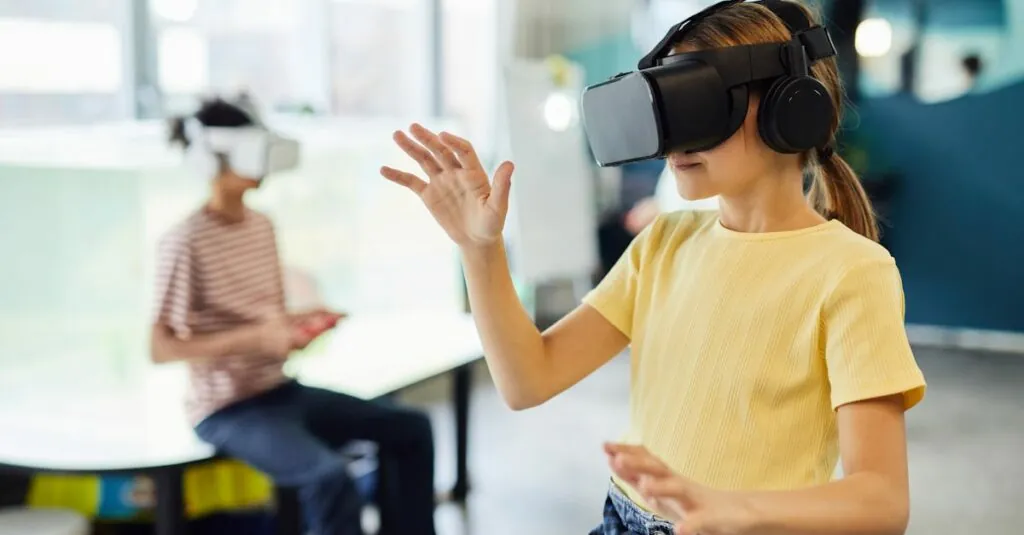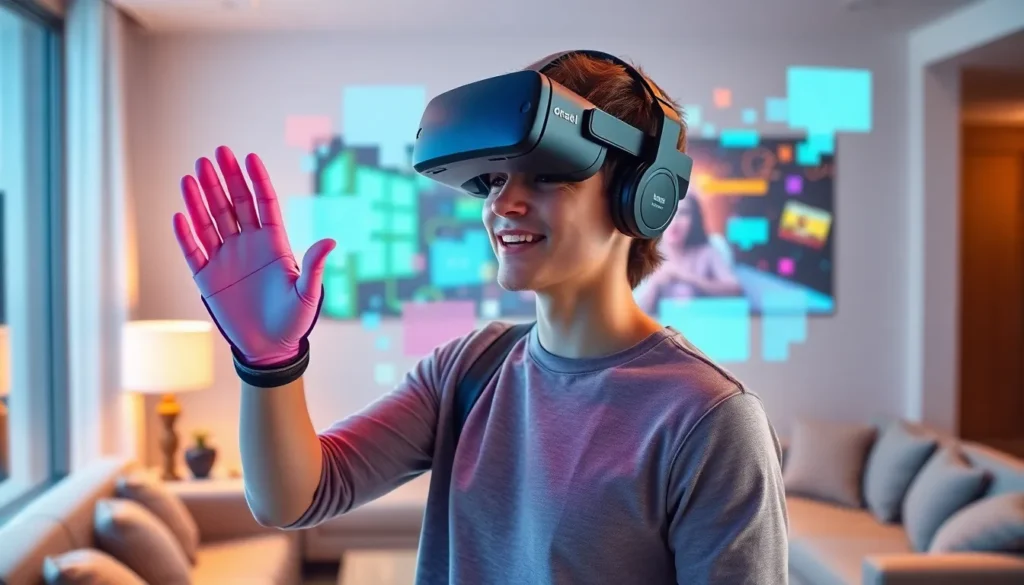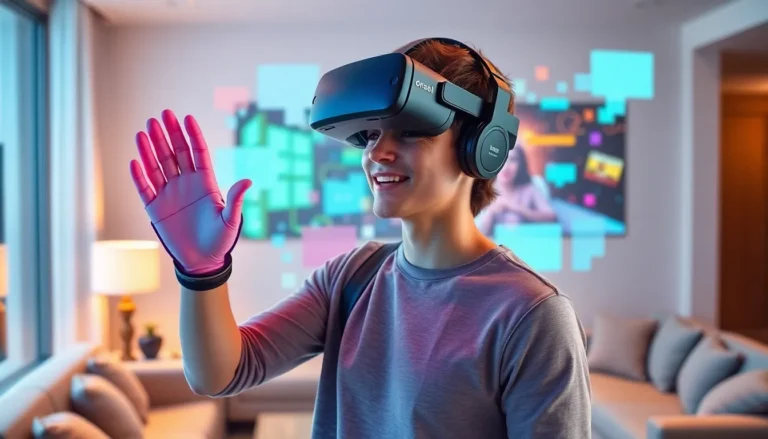Table of Contents
ToggleVirtual reality technology is taking the world by storm, and it’s not just for gamers anymore. Imagine stepping into a realm where your wildest dreams can become reality—without the messy cleanup afterward! From immersive training simulations to virtual travel experiences, new VR tech is redefining how people interact with the digital world.
As the lines between the real and virtual blur, it’s hard not to get excited about the possibilities. Whether you want to battle alien invaders or explore ancient ruins while still in your pajamas, the latest advancements in VR are making it all possible. Buckle up as we dive into the fascinating universe of new VR technology—where the only limit is your imagination (and maybe your Wi-Fi connection).
Overview of New VR Technology
New advancements in virtual reality technology expand its applications dramatically beyond traditional gaming. These innovations include enhanced graphics, improved tracking systems, and more intuitive user interfaces. Companies focus on creating immersive training environments for professionals in fields such as healthcare and aviation. Such environments allow users to practice critical skills without the risks associated with real-life scenarios.
Virtual reality also finds its way into social interaction. Users can attend virtual meetings, socialize with friends, or explore new environments together, irrespective of geographic boundaries. As the experience becomes more lifelike, communication via avatars mimics real-world interactions, offering more meaningful connections.
Content creators increasingly utilize VR for education. Interactive lessons in history or science engage students, making learning more enjoyable. By experiencing historical events or scientific concepts firsthand, learners retain information better and develop a deeper understanding of the subject matter.
Market trends suggest that consumer interest in VR devices is on the rise. Sales of VR headsets experienced a notable increase of 25 percent from 2022 to 2023, indicating growing acceptance. Moreover, advancements in hardware, such as lighter and more comfortable headsets, contribute to the appeal.
Developers also prioritize accessibility in their designs. Efforts include implementing features that accommodate users with disabilities. Such inclusivity ensures a broader audience can access and enjoy virtual experiences.
Ongoing research aims to enhance VR realism further. Innovations in haptic feedback technology allow users to feel sensations, bridging the gap between virtual and physical worlds. Continuous upgrades in VR applications ensure the technology remains relevant and appealing to diverse users.
Key Innovations in New VR Technology
Innovations in VR technology continue to reshape multiple industries. Users experience more immersive and engaging environments through advancements in hardware and software.
Advances in Hardware
Lightweight VR headsets enhance comfort during extended use. Improved resolution delivers stunning visuals, allowing users to immerse themselves in detailed worlds. Larger field of view increases peripheral awareness, making experiences more captivating. Superior tracking systems provide greater accuracy, facilitating smoother movements in virtual spaces. Wireless options eliminate cumbersome cables, promoting free motion. With battery life improvements, users enjoy longer sessions without interruptions. Companies increasingly prioritize ergonomic designs, prioritizing user comfort over long periods.
Enhancements in Software
Software advancements drive the evolution of VR experiences. Improved graphics engines create lifelike environments that engage the senses. Artificial intelligence integration personalizes interactions, catering to user preferences. Cross-platform compatibility expands accessibility, allowing more users to join virtual experiences effortlessly. Realistic physics engines enhance gameplay by mimicking real-world laws, enriching user immersion. Collaborative features in virtual meetings foster better communication, bridging distances. Increased availability of educational content leads to interactive lessons, making learning engaging and effective.
Applications of New VR Technology
New virtual reality (VR) technology continues to revolutionize various sectors. The capabilities of VR extend far beyond gaming, engaging users in transformative experiences.
Gaming and Entertainment
In gaming, immersive experiences capture players’ attention like never before. Players navigate complex environments that enhance realism and interactivity. With graphic quality improving, users enjoy lifelike details that elevate gameplay. Additionally, social gaming experiences allow friends to connect in virtual worlds regardless of distance. Notably, revenue in the VR gaming industry increased by over 30 percent from 2022 to 2023, showcasing a growing market demand. Developers focus on high-quality content to sustain player interest and engagement.
Education and Training
Education benefits significantly from VR applications, making subjects come alive. Interactive lessons foster deeper understanding for students. For example, history lessons transport learners to pivotal moments in time. Similarly, science classes enable virtual lab experiences without safety risks. Training simulations in professional settings allow users to practice essential skills in a controlled environment. Data indicates a 20 percent increase in academic performance in schools incorporating VR, improving student engagement. This innovative approach continues to attract educational institutions aiming for modernized learning experiences.
Healthcare Solutions
In healthcare, VR technology shows promising potential for patient treatment and professional training. Immersive simulations assist with surgical training, enabling surgeons to hone skills without real-life consequences. Pain management techniques utilize VR by distracting patients during procedures, proving effective in reducing anxiety. Moreover, mental health therapies increasingly include VR to help patients confront fears and phobias in a controlled setting. Research highlights a notable 30 percent decrease in anxiety levels among patients using VR therapy. As advancements continue, VR’s role in healthcare establishes new paradigms for patient care and professional development.
Challenges and Limitations of New VR Technology
New VR technology faces several challenges that hinder its widespread adoption.
Cost and Accessibility
High costs associated with VR hardware present significant barriers. Premium headsets and compatible devices can exceed $1,000, limiting access for many consumers. Additionally, ongoing expenses for software and upgrades add to the financial burden. Accessibility issues also arise for users with disabilities, as many VR experiences lack tailored features to accommodate diverse needs. Developers are working to address these gaps, yet progress remains slow. Institutions might prioritize budget over VR adoption, particularly in educational settings, despite evidence suggesting a 20 percent increase in academic performance associated with VR. If costs decrease, a broader user base could emerge, enhancing accessibility.
User Experience Concerns
User experience remains a critical factor influencing VR’s success. Motion sickness affects approximately 40 percent of VR users, leading to decreased enjoyment. Inconsistent comfort levels among different headsets also impact overall satisfaction. Interfaces must improve for easier navigation, particularly for less tech-savvy users. Feedback indicates that while immersive experiences are compelling, complex setups can deter participation. Developers strive to create user-friendly designs that minimize discomfort, yet additional work is necessary. If intuitive controls become standard, users may engage with VR more frequently, amplifying its appeal across various demographics.
Future Trends in New VR Technology
Innovations in VR technology are poised to redefine user experiences. High-resolution displays enhance visual fidelity, making virtual environments feel almost lifelike. Enhanced haptic feedback systems allow users to feel sensations, further bridging the gap between the virtual and physical worlds. Increased accessibility features ensure individuals with disabilities can fully engage with VR experiences, broadening the user base.
Emerging trends indicate a shift towards social VR platforms. These platforms encourage collaborative workspaces and social interaction, allowing users to connect meaningfully across distances. Significant advancements in AI will personalize user experiences, adapting environments based on preferences and behaviors. Gamification of educational content is also becoming prevalent, contributing to a 20 percent boost in student engagement rates.
Hardware improvements continue to emerge. Lighter headsets with extended battery life support longer sessions without fatigue. Wireless connectivity enhances mobility, creating seamless experiences in both gaming and professional settings. Market analysis shows a 25 percent growth in VR headset sales from 2022 to 2023, indicating rising consumer interest and demand.
Healthcare applications are expanding rapidly. Virtual reality is now utilized for anxiety reduction and treatment simulations, proving effective in clinical environments. With immersive surgical training programs, professionals gain hands-on experience while mitigating risks.
Overall, developers are addressing the limitations that have previously hindered adoption. Solutions to motion sickness, affecting around 40 percent of users, focus on refining user interface designs. Better comfort levels across headsets will also enhance satisfaction. Continuous research and development create a promising future for VR technology, ushering in an era of widespread acceptance and utilization across various industries.
The future of VR technology is undeniably bright and full of potential. As advancements continue to emerge, users can expect even more immersive and engaging experiences across various sectors. With improvements in hardware and software, the line between reality and virtual environments will blur further.
The ongoing efforts to address challenges like accessibility and user comfort indicate a commitment to making VR accessible for everyone. As industries embrace these innovations, the possibilities for training, education, and social interaction will expand, transforming how people connect and learn.
Exploring new VR technologies offers a glimpse into a world where experiences are limited only by imagination, paving the way for a truly interactive future.







